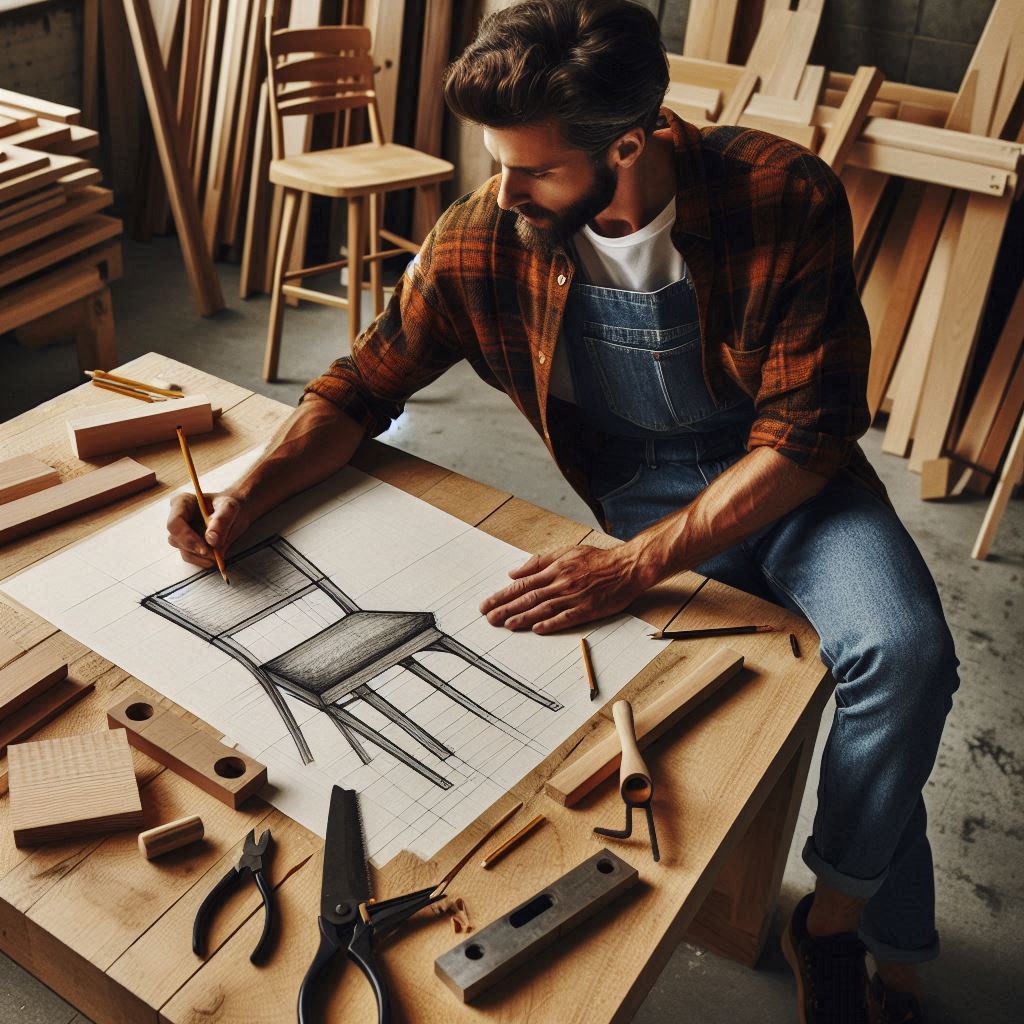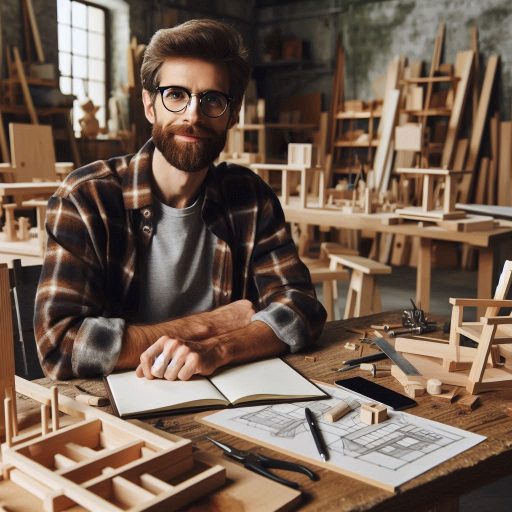Introduction
Entering furniture design competitions can elevate your career and showcase your creativity.
In 2024, several competitions stand out for aspiring designers.
The International Contemporary Furniture Fair (ICFF) invites innovative designs that push boundaries.
It offers a platform for emerging talent to shine and gain recognition.
The Furniture Design Awards recognize excellence across various categories.
Participants can gain valuable exposure and receive feedback from industry experts.
This recognition can significantly enhance a designer’s portfolio.
The Student Design Competition by the American Society of Furniture Designers encourages young talents to showcase their skills and creativity.
This competition nurtures the next generation of furniture designers.
Another noteworthy competition is the Red Dot Award, which honors outstanding product designs, including furniture.
Winning this prestigious award can dramatically boost your visibility in the industry.
The A’ Design Award also celebrates creative excellence across all design fields.
It provides an excellent opportunity to showcase your work globally.
Finally, the SaloneSatellite at Milan Design Week showcases young designers and connects them with industry leaders.
Entering these competitions can open doors and inspire new ideas.
Don’t miss the chance to make your mark in 2024!
Overview of Furniture Design Competitions in 2024
Overview of the various furniture design competitions
Furniture design competitions in 2024 offer exciting opportunities for designers to showcase their talent.
These competitions highlight creativity and innovation in furniture design.
Participating can boost your visibility in the industry and connect you with potential clients.
A’ Design Award
The A’ Design Award stands out among global competitions.
It recognizes outstanding designs across multiple categories, including furniture.
Winning this award can significantly enhance your portfolio.
It also provides international exposure, attracting attention from industry leaders.
International Design Awards (IDA)
Another prominent competition is the International Design Awards (IDA).
This competition celebrates exceptional designs in various fields, including furniture.
IDA promotes creativity and innovation, encouraging designers to push their boundaries.
Categories range from residential and office furniture to sustainable design solutions.
Designers can showcase their skills in multiple areas.
Red Dot Award
The Red Dot Award is another prestigious platform.
It honors innovative products, including furniture, and has a strong global reputation.
Winning a Red Dot Award signifies excellence in design and can enhance your professional credibility.
Furniture Design Awards
Additionally, the Furniture Design Awards focus on recognizing excellence in furniture design.
This competition evaluates creativity and functionality in various categories.
Participants can submit designs for residential, commercial, and public furniture.
This diversity allows designers to showcase their versatility and creativity.
Student Design Competition
For students, the Student Design Competition organized by the American Society of Furniture Designers is invaluable.
It encourages young talents to present their work.
This competition helps students gain experience and visibility in the industry.
It often includes categories tailored to their unique skills and perspectives.
Sustainable design competitions are increasingly popular in 2024.
Many organizations host competitions focused on eco-friendly and sustainable furniture solutions.
These competitions encourage designers to innovate while considering environmental impacts.
Sustainable Furniture Design Competition
The Sustainable Furniture Design Competition is a notable example.
It challenges participants to create designs that prioritize sustainability and functionality.
Milan Design Week
Moreover, the Milan Design Week features various competitions, including SaloneSatellite.
This event showcases young designers and emerging talents.
It offers a platform for them to connect with established industry professionals.
Design Vanguard Award
The Design Vanguard Award is another noteworthy competition.
It recognizes emerging designers who demonstrate exceptional talent and vision.
Participants compete in categories like furniture design, lighting, and textiles.
Furniture design competitions in 2024 offer a wide range of opportunities.
They cover various categories, from residential to sustainable design.
Renowned competitions like the A’ Design Award, International Design Awards, and Red Dot Award stand out for their credibility and prestige.
Emerging designers and seasoned professionals alike can benefit from entering these competitions.
Participating not only showcases your work but also opens doors to new opportunities and collaborations.
Embrace the chance to demonstrate your creativity and innovation in the dynamic world of furniture design!
Read: Top Skills Needed for Art Educators and Instructors
Criteria for Judging
Criteria that judges typically use to evaluate submissions
When entering furniture design competitions, understanding the judging criteria is crucial.
Judges typically evaluate submissions based on several key factors.
These include originality, functionality, innovation, sustainability, and marketability.
Each aspect plays a significant role in determining a design’s success.
Originality
Originality is essential in furniture design.
Judges look for unique concepts that stand out from the competition.
A design that offers a fresh perspective often grabs attention.
For example, the ‘Fabrico‘ chair by designer Maria Bergstrom won the ICFF in 2023 for its inventive use of fabric and shape.
Its distinctive design set it apart from conventional pieces.
Functionality
Functionality is another critical criterion.
Judges assess how well a piece serves its intended purpose.
A winning design should combine aesthetics with practicality.
The ‘Nest‘ table by John Doe exemplifies this balance.
Its innovative folding mechanism allows easy storage while maintaining an attractive form.
Innovation
Innovation showcases a designer’s ability to push boundaries.
Judges favor designs that incorporate new materials or technologies.
The ‘SmartSeat‘ by Jane Smith won accolades for integrating smart technology into a simple chair.
It features built-in sensors that adjust comfort based on user preferences.
Sustainability
Sustainability has become increasingly important in recent years.
Judges consider eco-friendly materials and production processes.
Submissions that prioritize environmental impact often score higher.
The ‘GreenBench‘ by EcoDesigners utilized reclaimed wood and recycled materials, impressing judges with its commitment to sustainability.
Marketability
Marketability is another vital aspect.
Judges evaluate whether a design can attract consumers and succeed in the marketplace.
A winning design should appeal to both aesthetics and functionality.
The ‘Modular Sofa‘ by DesignX proved highly marketable, offering customizable options for various living spaces.
Balancing the Criteria
Judges often look for a balance among these criteria.
A design that excels in originality but lacks functionality may not win.
Similarly, a sustainable piece without market appeal might struggle to impress.
Judges appreciate when designers thoughtfully consider all aspects of their work.
Past competitions have highlighted numerous designs that successfully met these criteria.
The ‘Wave‘ bookshelf by Anna Lee, for instance, won the Red Dot Award for its unique form and practicality.
It not only provides storage but also serves as an eye-catching art piece.
Aspiring designers should carefully consider these judging criteria.
Originality, functionality, innovation, sustainability, and marketability all play a significant role.
Understanding how judges evaluate these aspects can greatly enhance your chances of success.
Crafting a design that excels in all areas will undoubtedly make your submission stand out in the competitive landscape of furniture design competitions.
Embrace these guidelines and prepare to showcase your creativity in 2024!
Read: Collaborating with Other Creative Roles
Tips for Success
Entering furniture design competitions can be thrilling and challenging.
To increase your chances of success, follow these practical tips.
Transform Your Career Today
Unlock a personalized career strategy that drives real results. Get tailored advice and a roadmap designed just for you.
Start NowConduct Thorough Research
Research is crucial before starting your design.
Investigate previous competition winners and their projects.
Analyze what made their designs stand out.
Study current design trends and market demands.
Understand the competition guidelines and criteria thoroughly.
Tailor your design to fit the competition‘s theme and requirements.
This groundwork will provide you with a solid foundation for your project.
Embrace the Power of Sketching
Once you have a clear vision, begin sketching your ideas.
Sketching allows you to visualize your concepts quickly.
Focus on form, function, and aesthetics in your sketches.
Experiment with different styles and materials.
Keep refining your ideas on paper before moving to digital formats.
Good sketches help communicate your design intent clearly.
Develop Prototypes
Creating prototypes is essential for testing your designs.
Use materials that reflect your final product‘s quality.
Prototyping helps identify potential issues early in the process.
Test for durability, usability, and comfort.
Gather feedback from peers or mentors after presenting your prototype.
Use their insights to improve your design further.
This iterative process ensures your final submission is well-developed and thought-out.
Refine Your Design
After gathering feedback, refine your design meticulously.
Pay attention to details that can enhance functionality and aesthetics.
Ensure your design aligns with the competition criteria.
Consider sustainability and innovation as you refine your work.
High-quality finishes and craftsmanship can make a significant difference.
Take time to polish every aspect before finalizing your submission.
Communicate Your Concept Effectively
Presenting your design concept effectively is key to impressing the judges.
Prepare a compelling narrative that explains your design journey.
Highlight your inspiration, process, and the features that set your design apart.
Use visuals, such as sketches and prototypes, to support your presentation.
Clear communication will help judges understand your vision.
Practice Your Presentation
Before the competition, practice your presentation multiple times.
Familiarize yourself with the key points you want to emphasize.
Be prepared to answer questions about your design.
Confidence and clarity will enhance your presentation‘s impact.
Engaging storytelling can captivate judges and make your design memorable.
Maximizing your chances of success in furniture design competitions requires dedication and preparation.
Conduct thorough research, embrace sketching, and develop prototypes.
Refine your designs and communicate your concepts effectively.
By following these tips, you can elevate your work and leave a lasting impression on the judges.
Good luck!
Read: Breaking Down Iconic Movie Costumes

Key Deadlines and Submission Requirements
Entering furniture design competitions in 2024 can be both exciting and rewarding.
However, knowing the key deadlines and submission requirements is essential for your success.
Below, we highlight important dates and guidelines to ensure your entries stand out and impress the judges.
Key Deadlines
Each competition has specific submission dates that you must keep in mind.
For instance, the International Furniture Design Competition typically closes entries on March 15, 2024.
This competition is known for showcasing innovative designs, so aim to submit your best work.
Similarly, the Furniture Society’s Annual Design Competition has a deadline of May 1, 2024, which allows ample time for designers to prepare their entries.
Another notable competition is the SaloneSatellite Award, which usually requires submissions by February 28, 2024.
Mark these critical dates on your calendar to avoid any last-minute rushes.
Staying organized and aware of deadlines can significantly enhance your chances of success.
Submission Requirements
Submission requirements are another crucial aspect of the competition process.
Most competitions require high-quality images of your designs to present your work effectively.
Typical requirements include specific file formats, image resolutions, and supporting documents.
Generally, JPEG and PNG are the most widely accepted file formats for image submissions.
Some competitions may also accept PDF files, especially for detailed project descriptions and design briefs.
It‘s vital to check the guidelines for each competition to ensure you meet their specific requirements.
When it comes to image resolution, aim for a minimum of 300 DPI.
This ensures clarity and quality in both print and digital presentations.
High-resolution images allow judges to appreciate the details of your work, which can set your entry apart from others.
Additionally, many competitions require supporting documents such as a design brief, project statement, and sketches.
These documents should explain your design process and inspiration.
Providing clear and compelling explanations helps judges understand your vision and creativity.
Tips for Meeting Deadlines
To ensure you meet all deadlines and submission requirements, planning ahead is crucial.
Start your designs early, giving yourself ample time to refine your work and gather necessary materials.
Creating a checklist of all submission requirements can help keep you organized and focused.
Be sure to include file formats, image resolutions, and all supporting documents.
This approach will minimize the chances of overlooking any essential details.
Setting internal deadlines before the official ones can also be beneficial.
Completing your work ahead of time reduces stress and allows for necessary revisions.
Additionally, carefully reviewing submission guidelines ensures you understand each competition’s unique rules and requirements.
Following these guidelines closely increases your chances of acceptance.
Finally, don‘t hesitate to seek feedback from peers or mentors.
Sharing your work with others can provide valuable insights and enhance your design and presentation.
Before submission, double-check all your materials for completeness.
Confirm that all files are correctly named and organized.
By following these guidelines, you can effectively prepare for upcoming furniture design competitions in 2024.
Being mindful of deadlines and submission requirements sets you on the path to success.
Embrace this opportunity to showcase your creativity and innovation in the vibrant world of furniture design!
Read: Networking Events for Costume Designers
Networking Opportunities
Participating in furniture design competitions offers more than just a chance to showcase your work.
These events provide valuable networking opportunities that can significantly impact your career.
By engaging with industry professionals, potential clients, and other creatives, you position yourself for exciting collaborations, partnerships, and job prospects.
Leveraging these opportunities can lead to long-term professional growth and success.
Connecting with Industry Professionals
One of the primary benefits of entering furniture design competitions is the ability to meet influential industry professionals.
Competitions often attract established designers, manufacturers, and business leaders who serve as judges or sponsors.
Engaging with these individuals allows you to learn from their expertise and gain insights into current trends and market demands.
Building relationships with these experts can offer you mentorship and valuable career guidance.
Networking with professionals at these events also introduces you to key decision-makers in the furniture industry.
They may be scouting for emerging talent to collaborate with or bring on board for consulting opportunities.
Meeting Potential Clients
Competitions are also great platforms for connecting with potential clients.
Businesses, retailers, and brands frequently attend these events to discover fresh talent and innovative designs.
Presenting your work in such a public setting increases your visibility and allows potential clients to see your capabilities firsthand.
They may be looking for custom designs or unique approaches to solving design challenges.
Forming relationships with potential clients at these competitions can lead to lucrative collaborations or exclusive commissions.
The exposure you gain from interacting with a targeted audience of industry insiders can result in lasting business connections and new opportunities.
Collaborating with Other Creatives
Furniture design competitions also provide a unique environment for networking with other creatives.
Engaging with fellow designers fosters a sense of community, where ideas, techniques, and experiences are freely exchanged.
Meeting like-minded peers can spark creative collaborations, leading to innovative projects that might not be possible working solo.
Many successful partnerships are formed during these events, allowing designers to pool their skills and experiment with new techniques.
Networking with other participants can enhance your creative growth and broaden your design perspective, opening the door to exciting collaborative projects.
Job Opportunities
Competitions are a potential gateway to job opportunities.
Many companies and design firms use these events to scout for new talent.
Showcasing your work in a competitive environment demonstrates your ability to meet industry standards and push creative boundaries.
A strong performance or win can attract the attention of recruiters and hiring managers, leading to full-time roles, freelance gigs, or consulting opportunities.
Adding competition awards to your portfolio also boosts your professional credentials.
Employers value candidates who take initiative, and competitions are a great way to demonstrate your commitment to excellence.
Furniture design competitions offer numerous networking opportunities.
You can connect with industry professionals, meet potential clients, and collaborate with other creatives.
These interactions often lead to partnerships, job offers, and career growth.
Actively engaging with others at these events helps build relationships that can shape your future success in the furniture design industry.
Your next big opportunity might be waiting at your next competition!
Showcase Your Business Today
Reach thousands of readers actively exploring professional services. Publish your business profile and grow your audience now.
Publish NowDiscover More: Innovative Landscape Design Trends for 2024
Benefits of Winning
Entering and winning a furniture design competition can have a profound impact on a designer‘s career.
Beyond the thrill of victory, the benefits include exposure, recognition, credibility, and long-term opportunities.
Below, we discuss how winning can elevate your professional trajectory and open doors to new possibilities.
Exposure and Recognition
One of the most immediate benefits of winning a furniture design competition is the exposure it brings.
Competitions are often covered by industry publications, online platforms, and social media.
Winning can thrust your name into the spotlight, giving your work visibility to potential clients, manufacturers, and employers.
Designers who win prestigious competitions often receive interviews, features in design magazines, and invitations to exclusive events.
This level of exposure not only boosts your reputation but also connects you with key industry players.
Recognition from winning also validates your skills and creativity.
Judges in design competitions are usually respected professionals in the industry.
Earning praise from them enhances your credibility as a designer.
The recognition you receive from a win can set you apart from your peers and demonstrate your ability to innovate in a highly competitive field.
Boosting Your Portfolio
Winning a competition can significantly enhance your portfolio.
A successful competition entry shows potential clients or employers that you can work under pressure, meet strict guidelines, and deliver high-quality designs.
It proves that your work stands out among other designers.
This accomplishment can be a powerful asset in your portfolio, making it easier to secure freelance projects, jobs, or partnerships.
Having an award-winning design in your portfolio also signals a commitment to excellence.
It shows that your work has been vetted by industry experts and deemed exceptional.
This gives you a competitive edge when pursuing new opportunities.
Whether you‘re looking for a job, pitching your designs to a manufacturer, or starting your own brand, a win can be a major selling point.
Career Elevation
Winning a furniture design competition can serve as a career catalyst.
It can lead to job offers, collaborations with well-known brands, or partnerships with manufacturers.
Many past winners have gone on to have successful careers, gaining industry respect and landing prestigious contracts.
For instance, designers who have won the SaloneSatellite Award or the International Furniture Design Competition have seen their designs produced by major furniture brands.
Winning can also open doors to further education or mentorship opportunities.
Many competitions offer prizes that include mentorship from established designers or scholarships for advanced design programs.
These opportunities can sharpen your skills and expand your professional network, paving the way for future success.
Success Stories
Past winners of furniture design competitions have often gone on to make a significant impact in the industry.
For example, Tomoko Azumi, who won a major design competition early in her career, became one of the most respected names in modern furniture design.
Similarly, Benjamin Hubert, after winning the Young Designer of the Year Award, quickly rose to prominence and has since collaborated with leading global brands.
These success stories highlight how winning a design competition can change a designer‘s career trajectory.
It‘s not just about the prize money or a title ‘ it‘s about the doors it opens and the opportunities it creates for long-term career advancement.
Conclusion
Furniture design competitions in 2024 offer incredible opportunities for designers to showcase their creativity and gain recognition in the industry.
These events provide a platform for designers to present their work to a wider audience, including potential clients, manufacturers, and design experts.
By participating, designers can boost their portfolios, increase exposure, and establish credibility in a competitive market.
We encourage designers to enter these competitions to push design boundaries and explore innovative concepts.
Designers can receive valuable feedback from industry professionals, helping them grow and refine their work.
The networking opportunities and potential collaborations that arise from these competitions can also open doors to new career prospects.
Participating in these competitions allows designers to grow their skills and challenge their creativity.
Designers gain practical experience that propels their careers forward through these opportunities.
Whether you‘re an emerging talent or an experienced designer, these competitions are an excellent way to gain visibility and expand your professional reach.
We urge all designers to seize the opportunity and unlock their full potential in the dynamic field of furniture design.
[E-Books for Sale]
The Big Book of 500 High-Paying Jobs in America: Unlock Your Earning Potential
$19.99 • 500 High-Paying Jobs • 330 pages
Explore 500 high-paying jobs in America and learn how to boost your career, earn more, and achieve success!
See All 500 High-Paying Jobs of this E-Book
1001 Professions Without a Degree: High-Paying American Jobs You Can Start Now
$19.99 • 1001 Professions Without a Degree • 174 pages
Discover 1001 high-paying jobs without a degree! Unlock career tips, skills, and success strategies for just $19.99!




